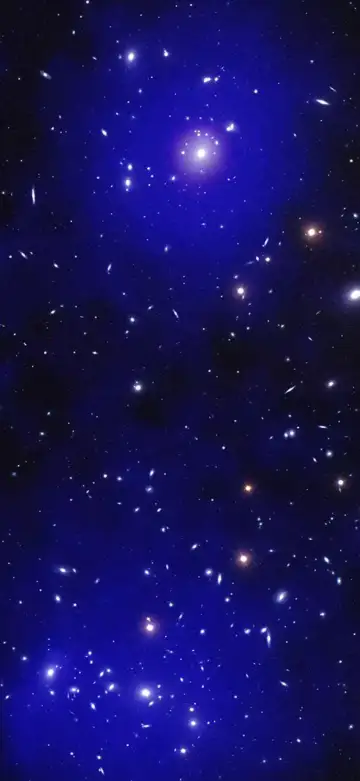
Warm-hot intergalactic medium observed between two colliding galaxy clusters. (Image credit: X-ray – NASA/CXC/CfA/A. Sarkar; Optical – NSF/NOIRLab/WIYN)
A significant portion of the mass in the local universe has not been accounted for. About a third of the matter created after the Big Bang, has yet to be detected within a few billion light-years of the Earth. Researchers suspect that this missing mass could be in warm or hot gas in between galaxies and galaxy clusters, and is known as the warm-hot intergalactic medium (WHIM). The existence of WHIM has been theoretical so far, and may have been directly detected for the first time by the Chandra X-ray observatory, in the space between a pair of galaxy clusters that are in the process of merging. The filaments of WHIM make up what is known as the cosmic web.
WHIM is a different cosmic puzzle than dark matter, a theoretical material to explain the missing mass in galaxies. When astronomers counted the visible stars in galaxies, including the Milky Way, they found that the galaxies had to have more masses to maintain their shapes, than was accounted for after counting all the stars within them. This mysterious, invisible matter is known as dark matter. WHIM is regular matter made up of hydrogen, helium, and other familiar elements that make up planets, stars and humans. Astronomers found evidence of WHIM in the material between colliding galaxy clusters in Abell 98, at a distance of about 1.4 billion light years from the Earth. Between the clusters are heated gases from the two clusters interacting, as well as gasses that fit within theoretical predictions of the upper limit of WHIM temperatures.
 The two colliding clusters. (Image credit: X-ray – NASA/CXC/CfA/A Sarkar, Optical -NSF/NOIRLab/WIYN)
The two colliding clusters. (Image credit: X-ray – NASA/CXC/CfA/A Sarkar, Optical -NSF/NOIRLab/WIYN)
Lead author of the study, Arnab Sarkarsays, “Finding these filaments of missing matter has proven to be exceptionally difficult, and only a few examples are known. We are excited that we have likely pinpointed another.” In addition, the data reveals a shock wave, similar to a sonic boom of a plane going supersonic. The shock wave is driven by the interactions between the galaxy clusters. Such a shock wave has been observed for the first time by astronomers, before the collision of two galaxy clusters. Co-author of the paper, Scott Randall says, “We think this shock wave is an important discovery because our models have predicted such features should be there, but we haven’t seen one until now. They’re a key part of the early collision process that will eventually lead to a merger of the clusters.”
Galaxy clusters are made up of thousands of galaxies, along with hot gas and reservoirs of dark matter. They are the largest known structures in the universe to be held together under the influence of mutual gravity. Co-author of the paper Yuanyuan Su says, “When galaxy clusters collide, we get a chance to see extreme physics that we rarely see in any other cosmic setting.” A paper describing the findings has been published in The Astrophysical Journal Letters.




 Driving Naari Programme launched in Chandigarh
Driving Naari Programme launched in Chandigarh






























